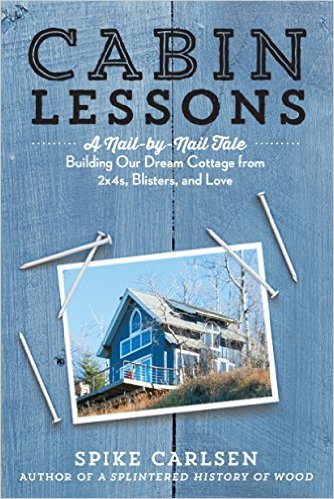Review by Angela Eckhart
“Our intent is to create a family cabin—a retreat to remain in the family for generations.”
 And that is precisely what Spike Carlsen and his wife, Kat, have done, along with their five children. Carlsen documents his cabin Oma Tupa’s creation (the cabin’s name meaning One’s Cabin in Finnish) in his memoir, Cabin Lessons: A Nail-by-Nail Tale, Building Our Dream Cottage from 2x4s, Blisters, and Love (Storey, April 2015). This is not just a how-to book, but a book about Carlsen’s life, including bittersweet passages about his family. Although they encounter some complications along the way, like financial issues, building difficulties, and environmental problems, the family forges on in not only building a strong cabin, but also building a stronger family bond. As Carlsen surmises, “Our cabin is the art of compromise memorialized in wood.”
And that is precisely what Spike Carlsen and his wife, Kat, have done, along with their five children. Carlsen documents his cabin Oma Tupa’s creation (the cabin’s name meaning One’s Cabin in Finnish) in his memoir, Cabin Lessons: A Nail-by-Nail Tale, Building Our Dream Cottage from 2x4s, Blisters, and Love (Storey, April 2015). This is not just a how-to book, but a book about Carlsen’s life, including bittersweet passages about his family. Although they encounter some complications along the way, like financial issues, building difficulties, and environmental problems, the family forges on in not only building a strong cabin, but also building a stronger family bond. As Carlsen surmises, “Our cabin is the art of compromise memorialized in wood.”
Carlsen begins his memoir with the quest for finding just the right location upon which to place the cabin. He and his wife are partial to the North Shore of Lake Superior, and they end up purchasing a “nearly inaccessible cliff of eroding clay” there owned by Dick and Jean. Carlsen’s dialogue and descriptions are both telling and witty. When Dick shows them the land, Carlsen writes:
We turn around to see him [Dick] completing the last part of the descent, wheezing, but standing. “I wish I could tell you two a little bit more about this land,” he pants. “I’ve owned it forty-seven years but only stepped foot on it three times: twice to hunt and once to help survey it. It’s just too damn hard to get around on.” Our guess is that Dick has never been in sales.
Once they purchase the land, things start rolling along quickly, including the “ten-ton boulder” that Carlsen discovers had dislodged from the mountainside and rolled over part of his newly-built stairs leading to the lake. Such minor catastrophes can force him to recall the list of “rules” for which to follow during the building process. Since the most important rule is, “It’s gotta be fun,” he decides that witnessing the boulder rolling “woulda been cool to see.”
Chapter Six centers on his wife, Kat, whom he hails as “wife, lifesaver, carpenter,” and the chapter is charming in that he writes about her with such love, respect, and admiration. It is especially entertaining when he includes his own amusing “commandments” during the building process, because, “Hell knoweth no fury like that of a woman who hath painted little friggin’ shingles for three hours only to have their use rejected by a boneheaded husband.” And in Chapter Eleven, “A Superior Lake,” he provides a detailed description of the area in travel-guide fashion, including the best places to see and the best places to eat, along with tour guide stories that are fascinating and historical.
Carlsen offers his carpentry and building acumen (such as notable lessons on wood), as well as his theoretical sentimentality. “Watching Kat, my wife, and Sarah, our oldest daughter, install deck boards at what to me as a seasoned carpenter seemed a glacial pace held a lesson in determining which was more important—a quickly built deck or the pride they felt in their newly honed skills.” His chapters with floorplan diagrams and tidbits about building permits and electrical codes offer interesting facts, especially for those of us who are not inclined to do-it-yourself, but the chapters about his family’s lives and the time they spend together are refreshing and endearing. There are a handful of photographs throughout the book; however, there definitely could have been more illustrations, especially if they had captured the image of his friend John’s Jeep practically dangling off of the cliff when he mistakenly maneuvered it when turning around.
Anyone, whether skilled in building or otherwise, should certainly delight in this book, which is both a guide on building a cabin and also a touching story about a second marriage for both and the merging of each other’s children to create a unified family. Obviously those with trade skills will enjoy the parts about the actual building processes, but others will simmer on his philosophical inclinations which can suggest valuable lessons for everyone, such as: “People need to marinate themselves in one another’s presence for a genuine length of time. They need to breathe the same air,” and “We always find, if we talk long enough, if we listen long enough, if we think long enough, we find a solution we can both live with.” But Carlsen’s best message is in the middle of the book in Chapter Nine when he compares knowing about different types of wood to human morality:
We need to take time to find out what species we are; what our natural strengths and weaknesses are. Rather than going against the grain to be something we’re not, maybe we should let ourselves grow in a more natural direction. We should be better craftsmen of our own lives.


